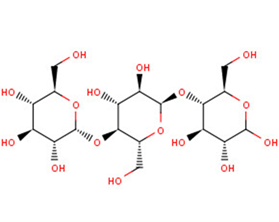
Maltotriose
CAS No. 1109-28-0
Maltotriose( D-Maltotriose | Amylotriose )
Catalog No. M20046 CAS No. 1109-28-0
Maltotriose is a common oligosaccharide metabolite found in human urine after maltose ingestion or infusion. Maltotriose is increased in Glycogen storage disease II due to a mutation of the enzyme alpha-14-glucosidase.
Purity : >98% (HPLC)
 COA
COA
 Datasheet
Datasheet
 HNMR
HNMR
 HPLC
HPLC
 MSDS
MSDS
 Handing Instructions
Handing Instructions
| Size | Price / USD | Stock | Quantity |
| 100MG | 43 | In Stock |


|
| 200MG | Get Quote | In Stock |


|
| 500MG | Get Quote | In Stock |


|
| 1G | Get Quote | In Stock |


|
Biological Information
-
Product NameMaltotriose
-
NoteResearch use only, not for human use.
-
Brief DescriptionMaltotriose is a common oligosaccharide metabolite found in human urine after maltose ingestion or infusion. Maltotriose is increased in Glycogen storage disease II due to a mutation of the enzyme alpha-14-glucosidase.
-
DescriptionMaltotriose is a common oligosaccharide metabolite found in human urine after maltose ingestion or infusion. Maltotriose is increased in Glycogen storage disease II due to a mutation of the enzyme alpha-14-glucosidase.
-
In Vitro——
-
In Vivo——
-
SynonymsD-Maltotriose | Amylotriose
-
PathwayOthers
-
TargetOther Targets
-
RecptorOthers
-
Research Area——
-
Indication——
Chemical Information
-
CAS Number1109-28-0
-
Formula Weight504.44
-
Molecular FormulaC18H32O16
-
Purity>98% (HPLC)
-
SolubilityDMSO:198.2 mM
-
SMILESOC[C@H]1O[C@H](O[C@@H]2[C@@H](CO)O[C@H](O[C@@H]3[C@@H](CO)OC(O)[C@H](O)[C@H]3O)[C@H](O)[C@H]2O)[C@H](O)[C@@H](O)[C@@H]1O
-
Chemical Name——
Shipping & Storage Information
-
Storage(-20℃)
-
ShippingWith Ice Pack
-
Stability≥ 2 years
Reference
1.Yuge O et al. Maltotriose and maltotetraose excreted in urine following intravenous administration of maltose to human volunteers. Jpn J Surg. 1983 Jul;13(4):296-303.
molnova catalog



related products
-
Hyponine D
Hyponine D is a natural product.
-
Methotrexate Triglut...
Methotrexate Triglutamate (MTXPG3) has potential anti-inflammatory activity and can be used to study arthritis and lupus erythematosus.
-
Desmethoxy yangonin
Desmethoxy yangonin protects LPS or LPS/D-GalN-induced damages in cell or liver tissues mainly through de-regulating IKK/NFκB and Jak2/STAT3 signaling pathways.



 Cart
Cart
 sales@molnova.com
sales@molnova.com


